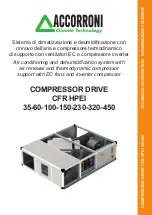
8 — ENG
D24087
1.
Before plugging in the air compressor, set the
adjustable pressure valve to "10" PSI. Make sure
the "ON/OFF" switch is in the "OFF" position.
2.
Connect the air tool or accessory to the air hose.
Tighten securely.
3.
Plug the power cord into the grounded outlet.
4.
Start the compressor by setting the "ON/OFF"
switch to the "ON" position.
TOO MUCH AIR PRESSURE COULD CAUSE
AN AIR TOOL OR VEHICLE TIRE TO RUPTURE
OR EXPLODE. CAREFULLY FOLLOW STEPS
5 AND 6 EACH TIME YOU USE YOUR COM-
PRESSOR.
5.
Check the manufacturer's maximum pressure
rating for the air tool, accessory or vehicle tire
being used. The air compressor outlet pressure
must never exceed the maximum pressure rating.
6.
Slowly increase the pressure setting of the adjust-
able pressure valve. You should be able to hear
and feel air pressure being relieved by the adjust-
able pressure valve. If pressure is not being
relieved, turn the air compressor off immediately.
The pressure valve must be replaced.
Compressed air from the outfit may contain
water condensation. Do not spray unfiltered
air at an item that could be damaged. Some air
operated tools or devices may require filtered
air. Read the instructions for the air tool or
device.
1.
Set the "ON/OFF" switch to "OFF" and unplug the
cord.
2.
Relieve all pressure from the air compressor head
and air hose by turning the adjustable pressure
valve to 10 P.S.I.
Air Hose
The air hose attached to your comporessor has an
integral pressure adjusting valve at the working end of
the hose. Should service or replacement be required,
make sure that the pressure adjusting valve is present
in the air hose line.
Do
NOT
replace the hose with standard
hose that is not equipped with the pres-
sure adjusting valve. The appropriate hose
assembly for your compressor is available
at Sears.
Do not allow hose to become kinked or
pinched at any time. This is important to
avoid damage to your compressor and to
maintain pressure adjusting valve control.
OPERATING PROCEDURES
STORAGE
When you have finished using the air compressor:
3.
Protect the electrical cord and air hose from
damage by winding them loosely around the air
compressor.
4.
Store the air compressor in a clean and dry
location.






































